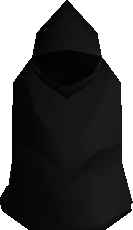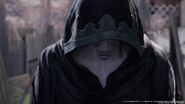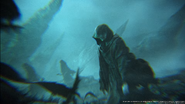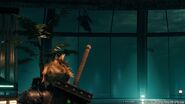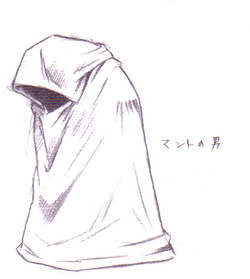
Sephiroth-clone artwork by Tetsuya Nomura.
We've finally released samples into town. They walk all around town, but do not seem to want to leave it. Furthermore, two of them are still in their pods. Again, no explanation is provided to me. Could the procedure have failed? No, impossible! Professor Hojo's experiments don't fail!
Researcher's Diary #4, Crisis Core -Final Fantasy VII-
The Sephiroth-clones[1] (セフィロス・コピー, Sefirosu Kopī?, lit. Sephiroth Copy), also known as Robed Men[2], are a group of test subjects used in the Project S portion of the Jenova Project in Final Fantasy VII. Cloaked men controlled by Sephiroth also appear in Final Fantasy VII Remake, although not directly being referred to as "clones". The test subjects were injected with Jenova's cells by Professor Hojo to test Jenova's ability to recall her scattered cells into a "Reunion", in what he called the "Jenova Reunion Theory". Hojo rejected many test subjects as failures, leading the exact number of people mutilated by this experiment to be unknown. The ones Hojo considered successes have a number tattoo somewhere on their bodies.
In the original Japanese script, the clones are known as Sephiroth Copies. "Clone" is a misnomer; subjects were infected with Jenova cells to reproduce a similar effect to that of Sephiroth—who eventually exerts control of the subjects as his puppets—rather than being genetic copies.
Characteristics[]
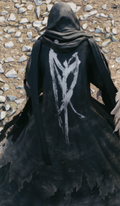
Robed man in "Episode INTERmission".
In Final Fantasy VII, all clones share a model of a fully robed dark figure, though their size varies, suggesting some of the clones may even be kids. When the characters observe these cloaked figures, they mention their numbered tattoos, but this is not shown on their character model. They shuffle around slowly and talk about Sephiroth and the reunion. Dio mentions a more coherent clone who apparently asked him questions and he does not mention anything odd about this encounter but their tattoo.
In Final Fantasy VII Remake, the robed men's features can be better perceived. They are tall men who appear very pale. They wear dark but tattered hooded robes with a large white abstract symbol on the back.
History[]
After the events of the Nibelheim Incident, Professor Hojo rounded up the survivors of Sephiroth's rampage, with the exception of Tifa Lockhart, who was rescued by Zangan before Shinra's arrival. He injected them with Jenova cells and exposed them to mako energy, similar, if not identical, to the creation of a SOLDIER member. Those not the finest in physical and mental health, and thus could not retain their senses of self, became shades of Jenova. Since Jenova was a puppet of Sephiroth, the clones also became fanatics who would do anything for their master.
Those who turned into mindless slaves were tattooed with a number somewhere on their body, but those who failed and kept some shred of their ego were left to die. Cloud Strife's status, had Zack Fair not intervened and rescued him from the Shinra Manor, is debatable. Zack, also a Sephiroth-clone, was a complete failure: he was not mentally affected by the experiment due to previously being unaffected by the identical SOLDIER procedure. The twelve successful Sephiroth-clones became the group of fanatics that follows Sephiroth around in Final Fantasy VII.
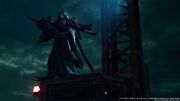
A Sephiroth clone holding Jenova's body in the remake.
In Final Fantasy VII Remake, two pale men in dark cloaks were seen: numbers 2 and 49. They were initially found staggering around the slums, but Cloud at times saw the clones as Sephiroth who taunted him in various ways. During the party's trek through the Shinra Building, they witnessed an apocalyptic vision of Sephiroth-clones and a burning Midgar and an approaching Meteor in the Shinra VR theater. Clone number 49 had also come to the building, and Cloud's party, as well as Shinra executive Palmer, saw him take the form of Sephiroth himself, who took Jenova's body from professor Hojo's lab and murdered the President and Barret before facing the party as Jenova Dreamweaver. Clone number 49 disappeared after being defeated and Barret was revived by the Whispers, but number 2 soon arrived to take Jenova's body and threw himself off the roof of the building.
In the original, the Sephiroth-clones did not migrate to Midgar as Hojo had predicted. Rather, the twelve headed into North Crater and hunted for the Black Materia for Sephiroth. Jenova herself broke out of the Shinra Building and moved towards Sephiroth in his form and under his complete control. Cloud was influenced by both the unconscious need for the Reunion, and his drive to avenge Nibelheim. After arriving at the North Crater, Sephiroth, using Jenova's body to shapeshift into his form, killed several of them before fighting Cloud and Avalanche as Jenova∙DEATH.
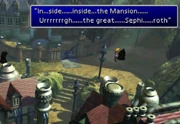
The party talks to a Sephiroth-clone in Nibelheim.
Only Cloud survived the journey to the North Crater, and thus became the only "success" of the Sephiroth-clone experiment; Cloud had his own mind and ego, but Sephiroth could still take control of him, although at times Cloud managed to resist Sephiroth's influence. At the North Crater, when Sephiroth revealed Cloud was a slave and claimed his past was an illusion, Cloud broke down and handed Sephiroth the Black Materia before falling into the lifestream.
Later, with the help of Tifa inside his subconscious, Cloud rebuilt his psyche and was restored to normal. After the battle with Safer∙Sephiroth, Sephiroth tried one last time to take over Cloud's mind, but was easily defeated thanks to Cloud's strengthened willpower. Sephiroth could no longer exert his power over him, and the Sephiroth-clones were finished.
In the novel Final Fantasy VII The Kids Are Alright: A Turks Side Story, it was revealed that Annette Townshend had been assigned to recover the missing test subjects. Her dead body, along with those of the copies, was discovered by her son, Evan Townshend, in a mako cavern beneath the Great Glacier to the north of Icicle Inn. Among the possessions found on her body was a small piece of Jenova's still-living flesh wrapped in a handkerchief, which was being pursued by Kadaj; Evan kicked it into the lifestream and Kadaj leapt in after it, dissolving.
In the film Final Fantasy VII: Advent Children, the children infected with Geostigma each carried a small portion of Jenova's cells. Kadaj told Rufus Shinra that "[his] brothers and sisters who share Mother's cells will all assemble" as part of the Reunion he and the other remnants of Sephiroth were planning. Thus, while those infected with Geostigma were different from, and were never referred to as, Sephiroth-clones, their role was roughly the same.
List of known Sephiroth-clones[]
Below is a list of every known Sephiroth-clone. This list omits several clones, as the fate of many numbered clones is never revealed or expanded upon.
- 1: A young man around Cloud's age. Went from North Corel to Gold Saucer. Had a tattoo on the back of his hand. Asked Dio if he had the Black Materia, as Dio later tells Cloud in the Speed Square.
- 2: The man suffering from mako poisoning in Sector 5 slums. Upon returning to Sector 5 with the Sector 5 Key, residents report seeing him leave "mumbling something about a reunion". In Final Fantasy VII Remake, he wears a black cloak like the others, and roams about the Sector 5 slums. A boy in the Children's Secret Hideout says that the man #2 used to be in SOLDIER. Near the end of the game he appears in the Shinra Building to recover Jenova's remains. He is revealed to have been an ex-SOLDIER by one of the children's fathers.
- 4: One of the people found in Nibelheim in Tifa's House's upstairs.
- 5: One of the people found in Nibelheim in Tifa's House's entrance.
- 6: One of the people found in Nibelheim's inn.
- 9: Exited from the Temple of the Ancients before dying. Had a tattoo on the back of his neck.
- 11: A man on the outskirts of Sector 7 slums in "Episode INTERmission". One of the people found in Nibelheim in Tifa's House's kitchen in Final Fantasy VII.
- 12: One of the people found in the Nibelheim Item Store.

Number 16 in INTERmission.
- 16: A man on the outskirts of Sector 7 slums in "Episode INTERmission".
- 20: A man on the outskirts of Sector 7 slums in "Episode INTERmission".
- Others: Four other clones appear in Nibelheim, but their numbers (if they had any) are not revealed. They include two clones found outside the Shinra Mansion and two tiny clones found in an attic (probably the children seen in Cloud's flashback, given the younger one's propensity to repeat his sister's words). These may have been given the numbers missing from the list above (3, 7, 8, and 10).
- Marco: Appears in Final Fantasy VII Remake and is tattooed with the number 49. He lives in the slums of Midgar, and Tifa is asked by Marle to look after him in his apartment in Sector 7. He is nearly attacked by Cloud to whom Marco appears as Sephiroth himself, but he is saved when Tifa intervenes. Sephiroth uses Marco several times as a host for his physical appearance, eventually using Marco the host body for assassinating President Shinra, and fighting the party as Jenova Dreamweaver. He appears to be killed when Jenova's body defeated. Marco (#49) also appears in the municipal storage area of the Sector 7 slums in "Episode INTERmission".

Cloud held as a rejected Sephiroth-clone in Crisis Core Reunion.
- Cloud Strife: The main character of Final Fantasy VII and Final Fantasy VII Remake. Went into a vegetative state after being injected with Jenova cells and exposed to mako, despite being labeled a failure. This assumption proved false, as he regained consciousness and was controlled by Sephiroth to an extent. One of the only clones to make it to the North Crater, but later threw off Sephiroth's control. Does not have a number.
- Zack Fair: The main character of Crisis Core -Final Fantasy VII-. Was unaffected by the Jenova cells, and was therefore labeled a failure. He does not have a number. In most depictions in the Final Fantasy VII series, Zack dies when gunned down by the Shinra army outside Midgar.
- Lilisa Meg: Appears in the "Picturing the Past" short story in Final Fantasy VII Remake World Preview, and is tattooed with the number 24.
- Glen Reiner: Appears in the "Picturing the Past" short story. His tattoo number is not revealed.
- Geddie Bach: Appears in the "Picturing the Past" short story. His tattoo number is not revealed.
- Broden: An inn keeper Cloud suspected of being former SOLDIER who made his home in the city of Kalm during Rebirth. Showing signs of ailment in their initial meeting after aiding Avalanche's escape, Broden later turns up as a Sephiroth-clone during their later journeys.
- Roche: After undergoing an experimental procedure courtesy of Hojo and succumbing to degradation in Final Fantasy VII Rebirth, Roche is reanimated as a Sephiroth-clone and dressed in a black robe. His tattoo, from his time as a SOLDIER 2nd Class, is SC42.
- Dale: Appears in Final Fantasy VII Rebirth living in Nibelheim.
The ex-SOLDIER who runs a weapon shop in Junon begins to wear a robe like the Sephiroth-clones when visited after the party has the Highwind in the original Final Fantasy VII. He states that a while ago, he felt the urge to dress like this, indicating the procedure that produced the Sephiroth-clones is the same treatment given to the members of SOLDIER.
In and around North Crater, 17 black cloaks are seen in Final Fantasy VII. These are likely to include the 11 surviving clones, as well as others with Jenova cells. If the player were to return to Nibelheim after viewing these scenes, the clones will still be there, although this is likely an oversight, as they disappear once the Meteor is summoned.
Eight of the nine Nibelheim clones are named in Final Fantasy VII The Kids Are Alright: A Turks Side Story. Their names are not identified with their numbers, however, the two that share a surname are likely the siblings. In the original game, the five caped characters that Cloud checks the number of he refers to as men.
The following five are confirmed dead following the events of North Crater:
- Kaitlin Stark (ケイトリン・スタークス, Keitorin Sutākusu?)
- Edmund Stark (エドモンド・スタークス, Edomondo Sutākusu?)
- Trevor Schoen (トレバー・ショーン, Torebā Shōn?)
- Ezra Monte (エズラ・モンティ, Ezura Monti?)
- Ian Meadows (イアン・メドウス, Ian Medōsu?)
The following three's bodies were not found:
- Rick Fergus (リック・ファーガス, Rikku Fāgasu?)
- Lisa Tutti (リサ・トゥッティ, Risa Tutti?)
- Senna York (セナ・ヨーク, Sena Yōku?)
Other media[]
The Sephiroth-clones, as well as Cloud's status as such—and more specifically Sephiroth placing the various clones, including Cloud himself, under control—were referenced in the third round of Mewtwo's Classic Mode Psychic Control (which deals with Mewtwo "recruiting" a defeated opponent in the next match) for Super Smash Bros. Ultimate.
Behind the scenes[]
In an early version of the game script, the Sephiroth-clones were not people, but, rather, parts of Jenova floating in the air covered by their cloaks. During important plot points they would reveal themselves to be pieces of Jenova's body: her right arm, heart, etc. They also replaced Sephiroth in several scenes, such as the pivotal one in the City of the Ancients.
At one point, Red XIII fears he might be a Sephiroth-clone due to Professor Hojo numbering him with a tattoo. This is untrue as the number was given to him in an unrelated experiment. In actuality, he was captured by Hojo more than three years after the Sephiroth-clones were created, confirmed by the Final Fantasy VII Ultimania Omega. His tattoo also uses the Roman numeral, while dialogue implies (and seen visibly in Final Fantasy VII Remake) that the clones use Arabic numerals.
In the original game the clones revealed no number higher than 12, while in Final Fantasy VII Remake the highest number seen is 49. This may be an allusion to the number 7 (7x7=49), and also perhaps because 4 and 9 are considered to be unlucky numbers in Japanese superstition: 4 is pronounced like shi (death) and 9 is pronounced like ku (suffering). It could also refer to the Buddhist concept of bardo, the intermediate stage between death and rebirth, which—according to some interpretations—can last for up to seven weeks (49 days). The robed men act as hosts to the true Sephiroth, who posthumously affects the mortal world by acting through them. In consideration of Sephiroth's themes and inspirations, the clones are evocative of Yakusa-no-ikazuchi-no-kami, who within Shinto religion are lightning demon servants of Izanami who act as her extensions into the mortal world.

